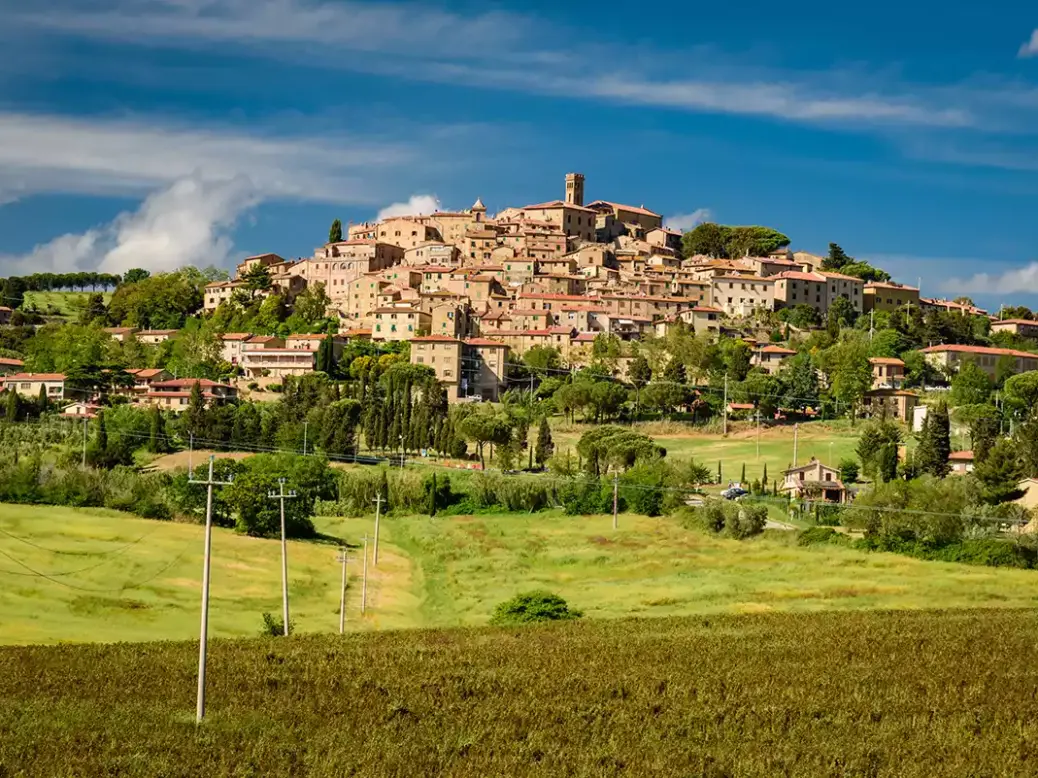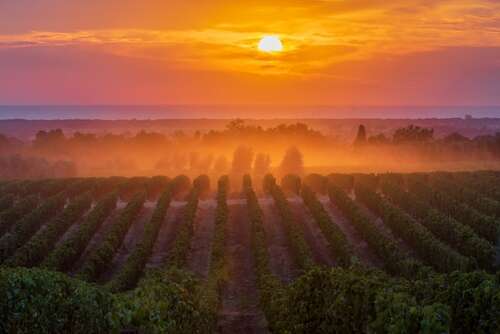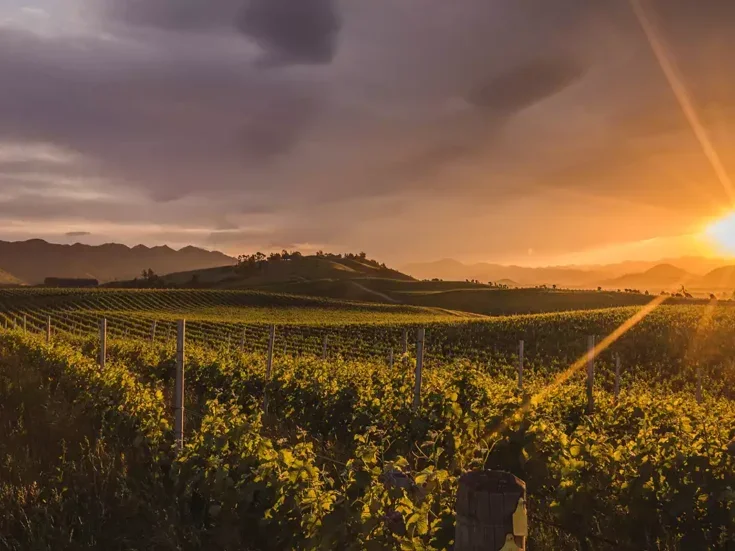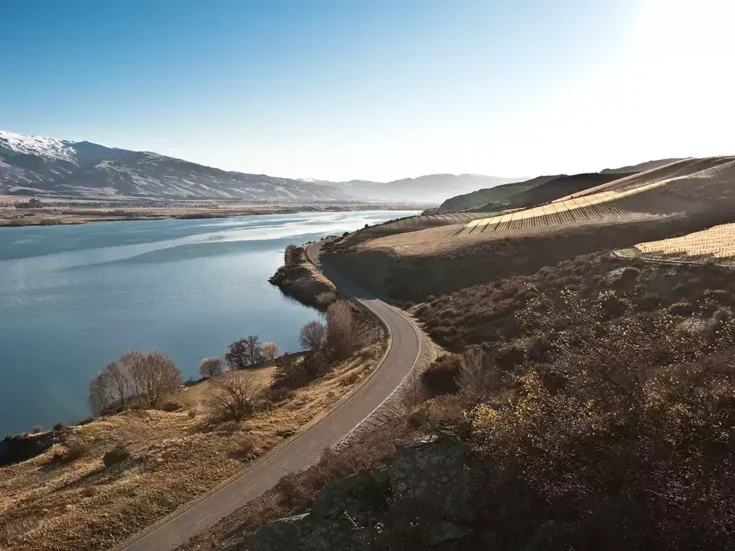
“Bolgheri is the best place in the world to ripen Cabernet Franc perfectly.” A bold claim from Riccardo Binda, Director of the Bolgheri Consorzio, but not without merit. I didn’t set out to write about the ascendancy of Cabernet Franc in Bolgheri, but on a flying visit to Podere Il Castellaccio on the Segalari hill I was intrigued by their silky-textured Cabernet Franc.
Cabernet Franc started life in Bolgheri as a supporting act to Merlot and/or Cabernet Sauvignon. Sassicaia has a smidgen (15 percent). But with warmer summers the variety has won favour for its freshness, fruit, and texture as part of a blend and increasingly as a standalone wine.
Over the past ten years, the surface area of Cabernet Franc has increased from 7 to 16 percent of the 1,544ha (3,815 acres) in Bolgheri planted to vine. The designated area is small, just 13km (8 miles) long and 7km (4 miles) wide and within this planting is restricted. Consequently, the majority of the single-variety Cabernet Franc wines—14 of 20—lie outside the circle of trust, those 1,365ha [3,370 acres] currently authorized to produce DOC wine in Bolgheri and Bolgheri Sassicaia, so these wines fly under the IGT banner Toscana Rosso.
It’s worth mentioning, however, that the Bolgheri Consorzio did recognize the potential of Cabernet Franc in 2011, permitting its use as a single-varietal DOC wine alongside Cabernet Sauvignon and Merlot. And there’s talk of the DOC area increasing, marginally, which would loop in some of those IGT outriders.

Bolgheri: A young, evolving region
Bolgheri is evolving. It is a young region, unashamedly so, free from the confines of tradition and able to react to changes in climate and taste. The average age of the vineyards is just 17 years. When planting began to really take off in the 1990s, Merlot was fashionable and well suited to the terroir, but in recent hot summers Merlot ripens too quickly especially at low altitude. It quickly accrues high sugar and it’s a challenge to fully ripen the skin. When asked about managing Merlot vineyards, Bolgheri producers grimace. Leaf cover can do only so much. I found single-varietal Merlot and Merlot-dominated blends a bit jammy in the 2021 vintage, which was released in January.
The 2021 summer was hot, well above average, although there were sufficient water reserves from a wet spring. The wines are rich, but with some of the elegance of 2019, the most refined of recent vintages. But 2022, like 2017, was very hot. The trend is undeniable, and producers are reconsidering choices in the vineyard, while a change of approach in the winery is par for the course for those producers in search of greater elegance in line with current tastes.
At Ca’Marcanda, Angelo Gaja took the radical step in 2008 of ripping it out his Merlot. Ca’Macanda started as a Merlot-dominated blend, but, after this dramatic change in direction, 2015 was the first release of the new blend of Cabernet Sauvignon supported by 20 percent Cabernet Franc. Not content with this alone, Gaja is flirting with whole bunch. Most producers eschew stems which are challenging to lignify in Bolgheri, but from 2020 Ca’Marcanda has 25 percent whole bunch which is used to provide a sense of freshness while absorbing some alcohol. I tasted 2021. It’s rich but finishes fresh. This is an example of a well-established estate that has found a new style with the help of Cabernet Franc.
Le Macchiole is well known for a richly sumptuous IGT Cabernet Franc called Paleo. This estate has moved to a more delicate extraction by employing a cooler fermentation at 24–27°C (75–81°F) with fewer pump-overs during a longer vatting period of 30–43 days. Coming largely from the sandy soil of the plain, Paleo is expressively fruity, but I feel 100 percent new oak barrique rather dominates the 2019. In 2020, 5 percent of the blend was kept separately in amphora to preserve freshness to combat the riper season—and it works in a wine that is really splashing.
A breezy newcomer
Now for a more recent arrival. Caccia al Piano began producing in earnest from 2013. I was drawn to their breezy bright and energetic Bolgheri Superiore 2021 which comes from a single vineyard, San Biagio. This drapes over a 180m (590ft) ridge with northwest and southeast exposures and rocky calcareous clay soil. The blend includes 40 percent Cabernet Franc which provides upfront fruit when the wine is young, while the Cabernet Sauvignon is there for structure and ageing potential. The 50 percent of new oak used for barrel ageing doesn’t dominate. After a year it is blended and moved to larger older oak. I like the saline finish.
Bolgheri vineyards range from sea level to 380m (1,250ft). The hillside vineyards are prized for the freshness of their fruit, but there is no denying that Bolgheri is a warm region and wine typically hits 14.5% alcohol. Vineyards on seaward-facing slopes, including those of Podere Il Castellaccio in the foot hills 4.5km (2.8 miles) from the Tyrrhenian Sea, benefit from salty coastal breezes. However, as Castellaccio’s owner Alessandro Scappini points, the sunlight reflected by the sea (the so-called “mirror effect”) can be stronger here on the slope, where the vineyards have an uninterrupted view of the sea, than it does on the plain.
Scappini’s tiny 0.5ha (1.2 acres) vineyard of Cabernet Franc, which was planted in 2009 on a moisture-retaining blue clay-schistous soil, faces the sea, and the 2021 Il Castellaccio hits a heady 15% alcohol, but nevertheless is fresh and energetic with an appetizing tart, bitter cherry and black chocolate note. It’s aged partly in concrete vats to preserve the freshness. Having had a bit more time to settle into itself, the 2020 is balanced, sleek, and streamlined. I love the silky textures of Scappini’s wines.
Much higher in the hills at 400m (1,310ft) and 10 km (6 miles) from the coast, Tenuta Sette Cieli has a 10ha (24 acres) vineyard which lies, in part, outside the Bolgheri delimitation. Winemaker Elena Pozzolini tells me the Cabernet Franc is harvested 15 days later at this altitude than vines on the plain. Here, where mid-summer temperatures peak at 30-31°C (86–88°F), versus 38–39° (100–102°F) below, the vines are planted on calcareous marly and quartz soils which retain sufficient moisture and where the vines never stress.
Pozzolini, who has made wine for 23 years, has adapted her approach over the past decade and now uses a cooler, longer fermentation and less time in oak. Tenuta Sette Cieli Scipio IGT Toscana 2019 is joyous with super blackcurrant fruit. For the altitude it’s surprisingly rich and richly textured, but also vibrantly energetic. There are hints of vanilla and asphalt, and the finish is juicy-fresh and imbued with captivating aromas of the garrigue.
No puckering pyrazine
Too often elsewhere in the world, Cabernet Franc leans into its puckering pyrazines, and frankly the sparse, herbaceous profile is not for me. In Bolgheri, however, Cabernet Franc can reach phenolic ripeness and produce sumptuously fruity wines with fine, smooth tannins. Bolgheri Cabernet Franc has a rather alluring perfume of soft garden herbs, without altogether escaping tomato leaf. I’ve mentioned Bolgheri’s high alcohol levels, but Cabernet Franc leavens the impression. The wines are not exactly transparent to terroir, but they are reflective.
And nowhere more so than in the southern section of Bolgheri. Here Tenuta Meraviglia planted Cabernet Franc on an unusual geological formation of marine and volcanic origin. Rhyolites are rare in Tuscany and only found in Bolgheri behind San Vincenzo. The soil, together with the slightly elevated altitude of 150m (490ft) and the sea-breezy microclimate, give their wines, which are aged in large untoasted oak, a savoury, miso minerality and fine-textured weave. This 30ha estate has the same ownership, team, and consultant (Alberto Antonini) as Dievole in Chianti Classico.
Meraviglia Bolgheri DOC 2020 (14%) is engagingly juicy and leafy, and you don’t feel the alcohol; it’s quite trim. The fine tannins have a light, crisp snap. I like the tingling mineral finish. (Bolgheri prices are punchy, but Meraviglia’s wines are very fair).
Maestro di Cava Bolgheri Superiore DOC 2018 (13.5%), a selection of the best vines, is quite a step up. It glides on silky tannins with a smoky, soft graphite feel. Power with elegance, despite, or more likely because of the wet summer coupled with the influence of Cabernet Franc. Delicate minty notes amplify the freshness on a layered palate with rather good intensity. I love the savory quality and the long, lead-pencil finish. Shame about the hefty bottle which doesn’t do the wine or the environment justice.
For their red wine, Meraviglia planted solely Cabernet Franc which seems particularly well suited to the volcanic soils in this specific part of Bolgheri, but some producers with broader planting are electing to use Cabernet Franc for their top-end offering.
At Poggio al Tesoro, Marilisa Allegrini’s Bolgheri estate, the icon wine, which is dedicated to Marilisa’s brother Walter, is 100 percent Cabernet Franc. Dedicato a Walter Bolgheri DOC Superiore is made from two rows within Poggio al Tesoro’s 7ha (17 acres) Via Bolgherese vineyard in the “Soprastrada,” the best section of the Bolgheri heartland. This lies above the Via Bolgherese at a small elevation of 56m (184ft) above sea level, and the soil is a mineral-rich mix of red sandstone and deep compact clays. The densely planted vines are 30 years old. The 2018, aged in 100 percent new oak, is concentrated, oaky, assertive, and alcoholic at 15%, but is also vigorous and has bags of freshness. Yes, it leans a bit into the herbal, but this is underpinned with marked intensity of fruit. A compact wine which punches into the finish and needs further ageing to unfurl.
My visit to Bolgheri was made, I confess, to taste the rare Tuscan grape Pugnitello. With so many indigenous varieties in Italy, I don’t gravitate to those from Bordeaux when I’m in the country. But I’m a terroirist above all and I found myself captivated by the symbiotic relationship between Cabernet Franc and this small pocket of coastal Tuscany, where Cabernet Franc has found its happy place and Bolgheri has found an eloquent ambassador for its terroir.






